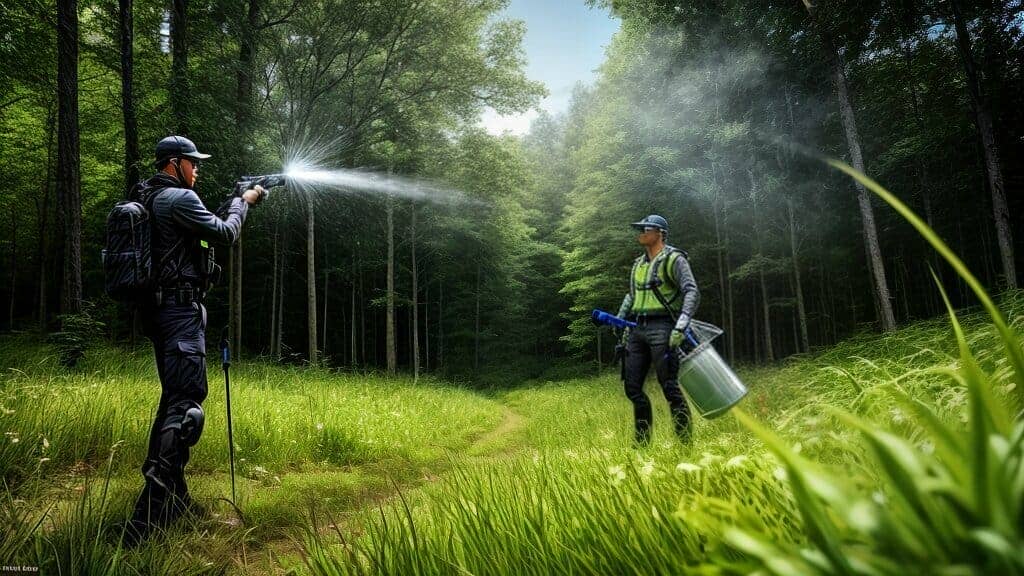Lyme Disease is a tick-borne illness that can have serious health consequences if left untreated. One common symptom of this disease is shortness of breath, which can be a sign of respiratory complications.
Understanding the symptoms of Lyme Disease and the connection to shortness of breath is crucial for early diagnosis and effective treatment. In this article, we will explore the link between Lyme Disease and shortness of breath, as well as provide tips and strategies for managing this symptom.
Key Takeaways:
- Lyme Disease is a tick-borne illness that can lead to respiratory complications.
- Shortness of breath is a common symptom of Lyme Disease.
- Early diagnosis and treatment of Lyme Disease is crucial for managing shortness of breath and other health complications.
Understanding Lyme Disease Symptoms
Lyme Disease is a bacterial infection transmitted to humans through the bite of an infected black-legged tick. The infection can cause a wide range of symptoms, many of which are often mistaken for other illnesses. Therefore, it is crucial to understand the symptoms of Lyme Disease for early diagnosis and treatment.
The symptoms of Lyme Disease can be divided into early stage and late-stage symptoms. Not everyone infected with the bacteria will experience all the symptoms, but those who do are likely to experience them in the following order:
| Early Stage Symptoms: | Late-Stage Symptoms: |
|---|---|
|
|
Respiratory symptoms are common in the late stage of the disease, including shortness of breath, difficulty breathing, and coughing. These symptoms can be debilitating and significantly reduce the quality of life for those affected. Therefore, it is essential to recognize and manage these symptoms as soon as possible.
The Link Between Lyme Disease and Shortness of Breath
Shortness of breath, also known as dyspnea, is a common symptom of Lyme Disease. The bacteria that cause Lyme Disease can lead to respiratory complications, including lung inflammation and pneumonia. These conditions can result in breathing difficulties and shortness of breath.
Lyme Disease can also affect the functioning of the heart, leading to heart palpitations and chest pain. The combination of heart and lung problems can make breathing even more challenging for those with Lyme Disease.
It is essential to recognize shortness of breath as a symptom of Lyme Disease and seek professional medical treatment. The sooner the disease is diagnosed, the better the chances of successful treatment and management of respiratory symptoms.

Managing Shortness of Breath in Lyme Disease
Shortness of breath can be a distressing symptom for individuals with Lyme Disease, but there are ways to manage it effectively. Here are some tips and strategies:
- Lifestyle changes: Making certain modifications to one’s lifestyle can help alleviate shortness of breath. These may include maintaining a healthy diet, engaging in regular physical activity, and practicing stress management techniques.
- Breathing exercises: Certain breathing exercises, such as pursed-lip breathing and diaphragmatic breathing, can improve lung function and reduce shortness of breath. These exercises should be done with the guidance of a medical professional.
At Oasis Medical Institute, individuals with Lyme Disease and shortness of breath can benefit from a range of holistic treatments, such as acupuncture and herbal medicine. In addition, the integrative approach at the clinic emphasizes the importance of addressing the root cause of the disease, rather than just managing symptoms.

If you are experiencing persistent or severe shortness of breath as a symptom of Lyme Disease, it’s important to seek medical help. The medical team at Oasis Medical Institute can provide expert evaluation and treatment for this and other respiratory symptoms.
The Integrative Approach at Oasis Medical Institute
Oasis Medical Institute in Tijuana, Mexico offers a comprehensive and integrative treatment program for individuals with Lyme Disease and shortness of breath. Led by medical director Dr. Francisco Contreras MD, the team at Oasis Medical Institute provides a holistic approach to care, combining traditional and alternative therapies for optimal results.
Their Lyme Disease treatment program includes advanced diagnostics, personalized treatment plans, and state-of-the-art therapies to address respiratory symptoms and other complications associated with the disease. Additionally, the facility offers a peaceful and healing environment for patients to recover and rejuvenate.
At Oasis Medical Institute, the team believes in treating the person as a whole, rather than just the disease. They employ a variety of complementary therapies, including acupuncture, massage, and nutritional counseling, to support the body’s natural healing processes. Their approach is designed to help patients not only manage their symptoms but also cultivate a greater sense of well-being and resilience.

Holistic Treatment Options for Shortness of Breath
For individuals with Lyme Disease experiencing shortness of breath, Oasis Medical Institute offers a range of holistic treatment options that can help alleviate symptoms and improve overall well-being. The integrative approach at Oasis Medical Institute combines conventional medicine with complementary therapies and alternative treatments, offering patients a comprehensive Lyme Disease treatment program tailored to their individual needs.
Some of the holistic treatment options available at Oasis Medical Institute for managing shortness of breath include:
| Treatment | Description |
|---|---|
| Oxygen Therapy | Oxygen therapy can improve breathing for individuals experiencing respiratory symptoms. At Oasis Medical Institute, patients receive customized oxygen therapy treatment plans to manage their shortness of breath. |
| Acupuncture | Acupuncture can help reduce inflammation and improve lung function, making it an effective treatment option for individuals with respiratory complications. Oasis Medical Institute offers acupuncture as part of their integrative approach to Lyme Disease treatment. |
| Herbal Medicine | Herbal medicine can help reduce inflammation and support respiratory health. The team of medical professionals at Oasis Medical Institute can recommend specific herbal remedies to manage shortness of breath in individuals with Lyme Disease. |
| Breathing Exercises | Breathing exercises can help improve lung capacity and reduce shortness of breath. Patients at Oasis Medical Institute can work with a respiratory therapist to learn breathing techniques that can improve their respiratory function. |
In addition to these treatments, Oasis Medical Institute encourages patients to make lifestyle changes that can improve their respiratory health. From maintaining a healthy diet to incorporating regular exercise and stress management techniques into their daily routine, patients at Oasis Medical Institute receive comprehensive support for managing their shortness of breath and other Lyme Disease symptoms.

Image Description: A person practicing yoga outdoors with a mountain landscape in the background.
The Integrative Approach at Oasis Medical Institute
Oasis Medical Institute in Tijuana, MX offers a comprehensive and integrative approach to Lyme Disease treatment, including support for individuals experiencing shortness of breath as a symptom. Medical director Dr. Francisco Contreras MD has over 30 years of experience in holistic medicine, and his team of specialists provide a range of personalized treatments to address the unique needs of each patient.
At Oasis Medical Institute, patients have access to advanced technologies and cutting-edge therapies, such as hyperbaric oxygen therapy, which can improve respiratory function and alleviate shortness of breath. Complementary therapies like acupuncture and massage therapy are also available to support overall wellness and promote relaxation.
With a focus on strengthening the body’s natural defenses and restoring balance, the team at Oasis Medical Institute works closely with patients to develop a customized treatment plan that may include conventional medications, as well as natural remedies and lifestyle modifications.
Experience holistic care and compassionate support for Lyme Disease at Oasis Medical Institute.

Lifestyle Changes for Better Breathing
For individuals with Lyme Disease experiencing shortness of breath, making lifestyle changes can significantly improve their respiratory health. Here are some tips:
- Eat a balanced, healthy diet: A diet rich in fruits, vegetables, lean protein, and healthy fats can support lung function and overall health.
- Exercise regularly: Light to moderate exercise can increase lung capacity and improve overall fitness. Consult a healthcare professional before starting any exercise program.
- Avoid smoking and secondhand smoke: Smoking can damage the lungs and exacerbate breathing difficulties. If you smoke, consider quitting. If you are around smokers, try to avoid their smoke.
- Manage stress: Stress can worsen shortness of breath. Practice relaxation techniques such as deep breathing, meditation, or yoga to help calm the mind and body.
- Avoid triggers: Identify and avoid environmental or other triggers that can cause breathing difficulties, such as air pollution, allergens, or extreme temperatures.
By incorporating these lifestyle changes into their daily routine, individuals with Lyme Disease can help manage their shortness of breath and improve their overall respiratory health.

Breathing Exercises for Lyme Disease
For individuals with Lyme Disease experiencing shortness of breath, practicing breathing exercises can be a helpful tool in managing symptoms. These exercises can improve lung function, reduce stress, and increase oxygen intake. Here are two effective breathing exercises to try:
Diaphragmatic Breathing
Also known as belly breathing, this technique involves breathing deeply into your diaphragm (lower chest) rather than into your upper chest. Follow these steps:
- Lie down on your back or sit comfortably with your back straight.
- Place one hand on your chest and the other on your belly.
- Inhale through your nose for 2-4 seconds, feeling your belly expand as you breathe in.
- Exhale through your mouth for 4-6 seconds, feeling your belly lower as you breathe out.
- Repeat for 5-10 minutes, focusing on deep, slow breaths.
This exercise can be done anytime, anywhere to help calm your mind and alleviate shortness of breath.
Pursed Lip Breathing
This technique can help control your breathing and reduce shortness of breath by keeping your airways open longer. Here’s how to do it:
- Sit down comfortably with your back straight.
- Inhale through your nose for 2 seconds.
- Purse your lips as if you were going to whistle.
- Breathe out slowly through your pursed lips for 4-6 seconds.
- Repeat for 5-10 minutes.
This exercise can be especially effective during times of exertion or when shortness of breath is more severe.

Medicinal Treatments for Respiratory Symptoms
For individuals with Lyme Disease who experience respiratory symptoms such as shortness of breath, there are medicinal treatments available to provide relief. Antibiotics are the primary treatment for Lyme Disease, and they can be effective in reducing inflammation and improving lung function. The specific antibiotics prescribed may vary based on the individual’s symptoms and medical history.
In addition to antibiotics, bronchodilators may be prescribed to individuals with respiratory symptoms. These medications work by relaxing the muscles that surround the airways, making it easier to breathe. Corticosteroids may also be used to reduce inflammation in the lungs and relieve breathing difficulties.
It is important to note that while medicinal treatments can be effective in managing respiratory symptoms, they may not be appropriate for everyone. It is essential to consult with a healthcare professional to determine the appropriate course of treatment based on individual needs and medical history.

In some cases, individuals may experience side effects from the use of medicinal treatments. These side effects may include nausea, headache, dizziness, and difficulty sleeping. It is important to discuss any concerns or side effects with a healthcare professional to ensure that the treatment is effective and safe.
Supportive Therapies for Respiratory Complications
For individuals with Lyme Disease and respiratory complications, there are various supportive therapies that can help manage shortness of breath and breathing difficulties. These therapies can improve lung function and overall respiratory health, providing relief and improving quality of life.
| Treatment | Description |
|---|---|
| Oxygen Therapy | Oxygen therapy involves the use of supplemental oxygen to improve breathing and increase oxygen levels in the blood. This treatment can be administered through a variety of methods, including nasal cannulas, face masks, and oxygen tanks. |
| Pulmonary Rehabilitation | Pulmonary rehabilitation is a comprehensive program designed to improve lung function and overall respiratory health. This program may include exercise training, breathing techniques, lifestyle counseling, and other supportive therapies. |
These supportive therapies can be provided as part of a comprehensive treatment program at medical facilities like Oasis Medical Institute. Dr. Francisco Contreras MD, the institute’s medical director, works with patients to develop personalized treatment plans that address their unique symptoms and needs.

Through a combination of holistic and conventional approaches, including supportive therapies, medicinal treatments, and lifestyle changes, individuals with Lyme Disease and respiratory complications can experience improved breathing and quality of life.
Preventing Lyme Disease and Shortness of Breath
Lyme Disease can be prevented with a few simple measures. If you’re spending time outdoors in an area where ticks are common, be sure to:
- Wear light-colored clothing to spot ticks more easily
- Wear long-sleeved shirts and pants, and tuck pants into socks to minimize skin exposure
- Use insect repellents that contain DEET or permethrin
- Check for ticks regularly, especially in warm and moist areas of the body like armpits, hairline, behind the knees, and groin
Early detection is key to preventing Lyme Disease and minimizing the risk of developing respiratory symptoms like shortness of breath. If you suspect that you have been bitten by a tick or have reason to believe that you may have contracted Lyme Disease, seek medical attention immediately.
By taking the necessary precautions and seeking prompt medical treatment, you can reduce the risk of developing shortness of breath and other complications associated with Lyme Disease.

Seeking Medical Help for Shortness of Breath
Individuals with Lyme Disease who experience persistent or severe shortness of breath should seek medical help immediately. Shortness of breath can be a symptom of respiratory complications that require urgent attention. Professional evaluation and treatment can help manage the symptoms and prevent further complications.

Ignoring shortness of breath can lead to a worsening of symptoms and eventually impact the quality of life. Seeking medical help can provide access to conventional medications and supportive therapies, such as oxygen therapy and pulmonary rehabilitation. Prompt treatment can also reduce the risk of permanent damage to the lungs and other organs.
Personal Stories of Overcoming Shortness of Breath
One of the most encouraging things for individuals with Lyme Disease and shortness of breath is hearing from others who have successfully managed this symptom. Their stories can offer hope and inspiration to those struggling with similar challenges.
Take, for example, Sarah, who was diagnosed with Lyme Disease after experiencing shortness of breath and chest pain. She worked with her healthcare provider to develop a treatment plan that included a combination of antibiotics, herbs, and lifestyle changes. Over time, her symptoms improved, and she was able to return to her normal activities.
Similarly, John, who had been struggling with shortness of breath for months, sought treatment at Oasis Medical Institute. Through a combination of holistic therapies, including oxygen therapy and pulmonary rehabilitation, he was able to manage his symptoms and improve his overall quality of life.
These personal stories highlight the importance of early detection and professional treatment for Lyme Disease and shortness of breath. By working with healthcare providers and exploring holistic treatment options, individuals can take control of their symptoms and find relief.

Image source: https://seowriting.ai/32_6.png
Conclusion: Lyme Disease and Shortness of Breath
In conclusion, understanding the relationship between Lyme Disease and shortness of breath is crucial for early diagnosis and effective treatment. Lyme Disease can lead to respiratory symptoms, including difficulty breathing, which can impact daily life and overall health. Fortunately, there are various holistic and medicinal treatments available to manage these symptoms, including oxygen therapy, breathing exercises, and lifestyle changes.
At Oasis Medical Institute in Tijuana, MX, individuals with Lyme Disease can benefit from an integrative treatment program that includes complementary therapies and alternative medicine. Medical director Dr. Francisco Contreras MD oversees the program and offers personalized care to patients experiencing shortness of breath.
It’s also important to take preventive measures to reduce the risk of developing Lyme Disease and respiratory complications. This includes tick prevention measures and early detection through professional evaluation and treatment.
Overall, if you or someone you know is experiencing persistent or severe shortness of breath as a symptom of Lyme Disease, seeking medical help is highly recommended. With the right treatment and lifestyle changes, it is possible to manage the symptoms and improve quality of life.
FAQ
Q: What is Lyme Disease?
A: Lyme Disease is an infectious disease caused by the bacterium Borrelia burgdorferi and is transmitted to humans through the bite of infected black-legged ticks.
Q: What are the symptoms of Lyme Disease?
A: Common symptoms of Lyme Disease include fever, headache, fatigue, muscle and joint aches, swollen lymph nodes, and a characteristic skin rash called erythema migrans.
Q: Can Lyme Disease cause shortness of breath?
A: Yes, Lyme Disease can lead to shortness of breath. The infection can cause lung problems and respiratory complications, resulting in difficulty breathing.
Q: How can shortness of breath be managed in Lyme Disease?
A: Shortness of breath in Lyme Disease can be managed through lifestyle changes, breathing exercises, and holistic treatment options. Consulting with a healthcare professional is recommended for personalized guidance.
Q: What holistic treatment options are available for shortness of breath in Lyme Disease?
A: Holistic treatment options for shortness of breath in Lyme Disease may include complementary therapies and alternative medicine. These approaches aim to address the underlying causes and provide relief.
Q: How can I book a consultation at Oasis Medical Institute?
A: To book a consultation at Oasis Medical Institute and learn more about their Lyme Disease treatment program, please contact [insert contact information].
Q: Are there lifestyle changes that can improve breathing in Lyme Disease?
A: Yes, maintaining a healthy diet, engaging in regular exercise, and practicing stress management techniques can support better breathing for individuals with Lyme Disease.
Q: Are there specific breathing exercises for managing shortness of breath in Lyme Disease?
A: Yes, specific breathing exercises and techniques can help individuals with Lyme Disease manage shortness of breath. Regular practice is important for optimal results.
Q: What medicinal treatments are available for respiratory symptoms in Lyme Disease?
A: There are conventional medications that can be prescribed to manage respiratory symptoms in Lyme Disease. Consultation with a healthcare professional is recommended to determine the most appropriate treatment.
Q: Are there supportive therapies for respiratory complications in Lyme Disease?
A: Yes, supportive therapies such as oxygen therapy and pulmonary rehabilitation can assist individuals with Lyme Disease and respiratory complications. These treatments aim to improve breathing and overall lung function.
Q: How can Lyme Disease and shortness of breath be prevented?
A: Preventing Lyme Disease involves measures such as avoiding tick-infested areas, wearing protective clothing, using insect repellent, and conducting regular tick checks. Early detection is crucial in reducing the risk of developing shortness of breath as a symptom.
Q: When should I seek medical help for shortness of breath in Lyme Disease?
A: It is important to seek medical help if you experience persistent or severe shortness of breath as a symptom of Lyme Disease. Professional evaluation and treatment can help manage the symptoms effectively.
Q: Are there any personal stories of individuals overcoming shortness of breath in Lyme Disease?
A: Yes, there are personal stories and testimonials of individuals who have successfully managed shortness of breath associated with Lyme Disease. These stories can provide inspiration and insights into effective strategies.
Dr. Francisco Contreras, MD is a renowned integrative medical physician with over 20 years of dedicated experience in the field of integrative medicine. As the Medical Director of the Oasis of Hope Hospital in Tijuana, Mexico, he has pioneered innovative treatments and integrative approaches that have been recognized globally for the treatment of cancer, Lyme Disease, Mold Toxicity, and chronic disease using alternative treatment modalities. Dr. Contreras holds a medical degree from the Autonomous University of Mexico in Toluca, and speciality in surgical oncology from the University of Vienna in Austria.
Under his visionary leadership, the Oasis of Hope Hospital has emerged as a leading institution, renowned for its innovative treatments and patient-centric approach for treating cancer, Lyme Disease, Mold Toxicity, Long-Haul COVID, and chronic disease. The hospital, under Dr. Contreras's guidance, has successfully treated thousands of patients, many of whom traveled from different parts of the world, seeking the unique and compassionate care the institution offers.
Dr. Contreras has contributed to numerous research papers, articles, and medical journals, solidifying his expertise in the realm of integrative medicine. His commitment to patient care and evidence-based treatments has earned him a reputation for trustworthiness and excellence. Dr. Contreras is frequently invited to speak at international conferences and has been featured on CNN, WMAR2 News, KGUN9 News, Tyent USA, and various others for his groundbreaking work. His dedication to the medical community and his patients is unwavering, making him a leading authority in the field.
Contreras has authored and co-authored several books concerning integrative therapy, cancer, Lyme Disease and heart disease prevention and chronic illness, including "The Art Science of Undermining Cancer", "The Art & Science of Undermining Cancer: Strategies to Slow, Control, Reverse", "Look Younger, Live Longer: 10 Steps to Reverse Aging and Live a Vibrant Life", "The Coming Cancer Cure Your Guide to effective alternative, conventional and integrative therapies", "Hope Medicine & Healing", "Health in the 21st Century: Will Doctors Survive?", "Healthy Heart: An alternative guide to a healthy heart", “The Hope of Living Cancer Free”, “Hope Of Living Long And Well: 10 Steps to look younger, feel better, live longer” “Fighting Cancer 20 Different Ways”, "50 Critical Cancer Answers: Your Personal Battle Plan for Beating Cancer", "To Beat . . . Or Not to Beat?", and “Dismantling Cancer.”






















